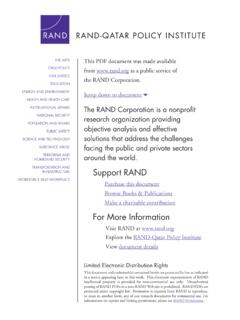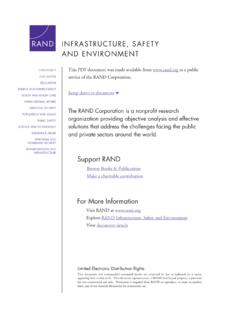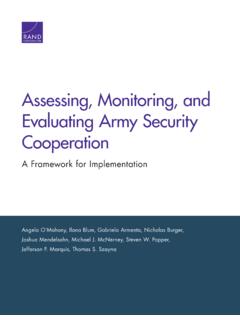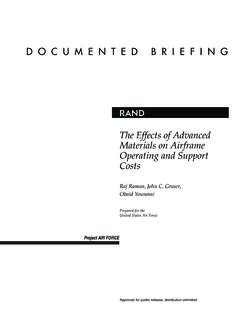Transcription of ANDREW SCOBELL, EDMUND J. BURKE, CORTEZ ... - RAND …
1 C O R P O R AT I O N. ANDREW SCOBELL, EDMUND J. BURKE, CORTEZ A. COOPER III, SALE LILLY, CHAD J. R. OHLANDT, ERIC WARNER, WILLIAMS. China's Grand Strategy Trends, Trajectories, and Long-Term Competition For more information on this publication, visit Library of Congress Cataloging-in-Publication Data is available for this publication. ISBN 978-1-9774-0185-4. Published by the rand corporation , Santa Monica, Calif. Copyright 2020 rand corporation R is a registered trademark Cover image design: Katherine Wu PRC flag with yuan: Dmytro/Adobe Stock Chinese Military: Mike/Adobe Stock Limited Print and Electronic Distribution Rights This document and trademark(s) contained herein are protected by law. This representation of rand . intellectual property is provided for noncommercial use only. Unauthorized posting of this publication online is prohibited.
2 Permission is given to duplicate this document for personal use only, as long as it is unaltered and complete. Permission is required from rand to reproduce, or reuse in another form, any of its research documents for commercial use. For information on reprint and linking permissions, please visit The rand corporation is a research organization that develops solutions to public policy challenges to help make communities throughout the world safer and more secure, healthier and more prosperous. rand is nonprofit, nonpartisan, and committed to the public interest. rand 's publications do not necessarily reflect the opinions of its research clients and sponsors. Support rand . Make a tax-deductible charitable contribution at Preface This report documents research and analysis conducted as part of a project entitled Long-Term Competition sponsored by the Deputy Chief of Staff, G-3/5/7, Army.
3 The purpose of the project was to help the Army understand the shift- ing relative capabilities of the and Chinese militaries over the next 35 years. This report should be of interest to anyone in the national security community , especially planners and strategists. This research was conducted within rand Arroyo Center's Strategy, Doctrine, and Resources Program. rand Arroyo Center, part of the rand corporation , is a federally funded research and development center (FFRDC) sponsored by the United States Army. rand operates under a Federal-Wide Assurance (FWA00003425) and com- plies with the Code of Federal Regulations for the Protection of Human Subjects Under United States Law (45 CFR 46), also known as the Common Rule, as well as with the implementation guidance set forth in DoD Instruction As applicable, this compliance includes reviews and approvals by rand 's Institutional Review Board (the Human Subjects Protection Committee) and by the Army.
4 The views of sources utilized in this study are solely their own and do not represent the official policy or position of DoD or the Government. iii Contents Preface.. iii Figures and Tables.. vii Summary.. ix Acknowledgments.. xv Abbreviations.. xvii CHAPTER ONE. Introduction.. 1. Methods and Approach.. 1. CHAPTER TWO. Grand Strategies for China.. 5. Grand Strategy and Interstate .. 5. An Evolving PRC-USA Rivalry.. 6. China's Evolving Grand .. 9. Conclusion.. 21. CHAPTER THREE. Framing the Future: Political Control and Social Stability.. 23. Leadership and System.. 24. Maintaining Social Stability.. 31. The Domestic Drag on National Defense.. 33. Conclusion.. 35. CHAPTER FOUR. Rebalancing Diplomacy and Economics, Restructuring Science and .. 37. Diplomatic Rebalancing Strategy.. 37. Rebalancing the Economy: Reform or Restructuring?
5 45. Restructuring Science and .. 61. Assessing China's S&T .. 70. Conclusion.. 71. v vi China's Grand Strategy: Trends, Trajectories, and Long-Term Competition CHAPTER FIVE. Restructuring National Defense.. 73. Restructuring the PLA to Achieve Rejuvenation: China's National Military Strategy.. 73. Restructuring the PLA to Achieve Rejuvenation: The Future Takes Shape.. 80. Assessing the National Defense Strategy.. 96. Conclusion.. 97. CHAPTER SIX. Future Scenarios, Competitive Trajectories, and Implications.. 101. China 2050 Scenarios.. 102. Scenario Analysis and Implications for DoD.. 111. Alternative Competitive Trajectories.. 114. Implications for the .. 116. References.. 121. Figures and Tables Figures Factors and Time .. 4. PRC Grand Strategy and Subordinate Strategies.. 11. Distribution of Confucius Institutes by World Region.
6 43. Chinese Household Consumption and Investment as a Share of GDP.. 47. Chinese Exports as a Share of GDP.. 49. Share of Chinese Population by Age.. 60. China's Gross Expenditures on Research and Development as a Percentage of GDP, 1994 2014.. 63. R&D Expenditures as a Percentage of GDP for Selected Countries, 2005 2012 .. 63. China's Government Appropriations for Education as a Percentage of GDP, 2005 .. 64. Science and Engineering Bachelor's Degrees by Location, 2000 2012.. 65. Doctoral Degrees in Science and Engineering by Location, 2000 2013.. 65. Estimated Number of Researchers by Location, 2000 2013.. 66. Internationally Mobile Students Enrolled in Tertiary Education by Location, 2013.. 66. Sample of China's Development Plans and Priorities.. 69. PLA Structure Pre-Reform.. 81. PLA Structure Post-Reform.
7 82. China's Five New Theater .. 83. Alternative Competitive Trajectories.. 114. Tables China's Grand Strategies Since 1949.. 14. Strategic Emerging Industries.. 67. Chinese PME Discussion of Warfighting Strengths, 1986 .. 87. China Future Scenarios.. 104. vii Summary China and the United States will likely be in competition with each other for many years to come. Indeed, the two countries seem destined to be locked into long-term competition because neither is likely to withdraw from world affairs in the foreseeable future. In addition, each country perceives the other country as a significant rival, is deeply suspicious of the actions and intentions of the other country, and is highly competitive. To explore what extended competition between the United States and China might entail through the year 2050, this report focuses on identifying and character- izing China's grand strategy, analyzing its component national strategies (diplomacy, economics, science and technology [S&T], and military affairs), and assessing how successful China might be at implementing these over the next three decades.
8 Foun- dational prerequisites for successful implementation of China's grand strategy are deft routine management of the political system and effective maintenance of social stabil- ity. China's grand strategy is best labeled national rejuvenation, and its central goals are to produce a China that is well governed, socially stable, economically prosperous, technologically advanced, and militarily powerful by 2050. China's Communist Party rulers are pursuing a set of extremely ambitious long-term national strategies in pursuit of the overarching goals of their grand strategy. Two fundamental questions are at the heart of this report: (1) What will China look like by 2050? (2) What will relations look like by 2050? The answers are provided by analyzing trends in the management of politics and society and study- ing national-level strategies in diplomacy, economics, S&T, and military affairs.
9 Using these analyses, the report develops a range of possible future scenarios for mid-21st-century China and then generates an accompanying set of potential future trajectories for long-term competition. Four Scenarios The four scenarios of what China might look like by 2050 are ix x China's Grand Strategy: Trends, Trajectories, and Long-Term Competition 1. triumphant China, in which Beijing is remarkably successful in realizing its grand strategy 2. ascendant China, in which Beijing is successful in achieving many, but not all, of the goals of its grand strategy 3. stagnant China, in which Beijing has failed to achieve its long-term goals 4. imploding China, in which Beijing is besieged by a multitude of problems that threaten the existence of the communist regime. Four elements are analyzed for each scenario: the overall forecast for China's development and ability to achieve its goals the specific domestic and foreign conditions required for the scenario to occur the outcome of the scenario in terms of China's influence in the world the scenario's consequences for the United States.
10 This report concludes that any one of these four scenarios ranging from stun- ning success in achieving China's grand strategy at one extreme to abject failure at the other extreme is possible three decades hence. But a triumphant China is least likely because such an outcome presumes little margin for error and the absence of any major crisis or serious setback between now and 2050 an implausible assumption. At the other extreme, while an imploding China is conceivable, it is not likely because, to date, Chinese leaders for the most part have proved skilled at organizing and planning, adept at surmounting crises, and deft at adapting and adjusting to changing conditions. By 2050, China most likely will have experienced some mixture of successes and failures, and the most plausible scenarios would be an ascendant China or a stagnant China.

















